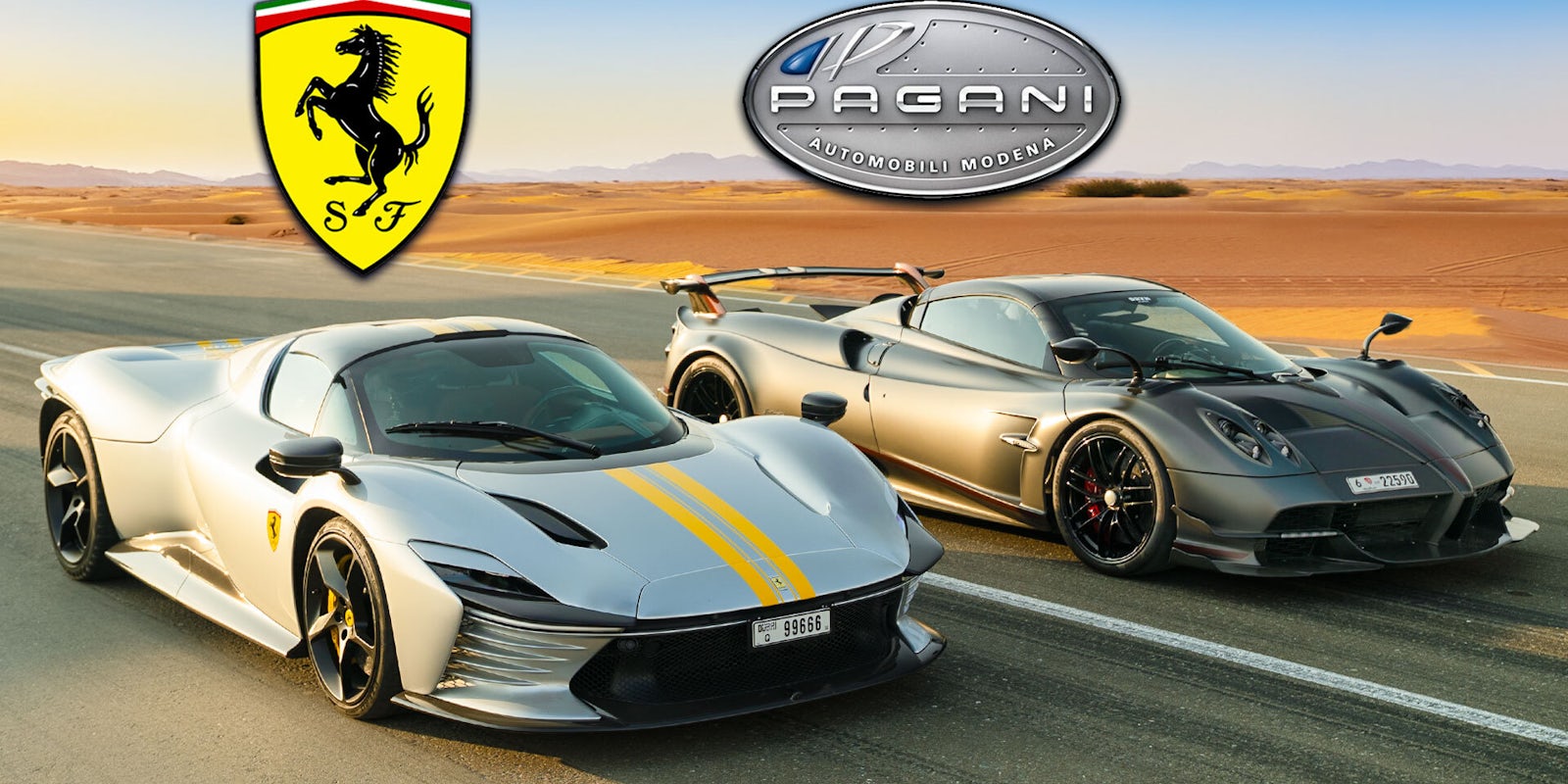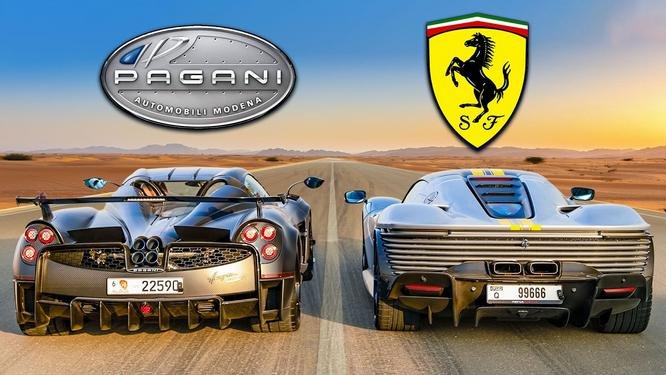Powertrain Duel: Comparing Horsepower, Torque, and Engine Tech

Split-Second Launches: Analyzing Launch Control and 0–60 Runs
There’s a ritual to launching a multi-million-dollar hypercar, one that feels almost sacred: a firm press on the brake, a precise rev-match to the launch-control sweet spot, then a split-second release that transforms an apex predator into a pinned-back projectile. Both the Daytona SP3 and Pagani Huayra Roadster BC wield advanced launch-control systems that modulate torque, manage wheelspin, and coax maximum grip from sticky rubber on unforgiving tarmac. In Al Ain’s still-cool pre-dawn air, I watched the SP3’s wheelspin flicker across the asphalt, the Prancing Horse’s traction control deftly clawing back slip as the naturally aspirated V12 held a perfect launch rpm. Moments later, the Pagani’s tyres chirped in protest, then soothed by its electronics as its turbos flared, generating an abrupt surge that felt almost unfair. On paper, Ferrari claims a 0–62 mph sprint in just 2.85 seconds, while Pagani lists 0–60 mph in 3.3 seconds, figures that underscore the Daytona’s raw edge in straight-line acceleration [2]. Yet that 0.45-second differential belies the Huayra’s prodigious turbocharged torque—1,050 Nm—that surges like a coiled spring, snapping the head back with such ferocity you’ll swear time slows around you [3]. Reaction time and electronic finesse often decide these duels as much as peak numbers. Have you ever wondered why two cars with similar horsepower can launch so differently? It comes down to RPM at launch, clutch bite points, tyre compound, and even ambient temperature—factors that engineers obsess over when calibrating these systems. I remember joking with a technician that a hypercar’s launch-control programming must be akin to fine-tuning a grand piano; the slightest misalignment and the symphony falls apart. And yet, when you nail it, what feels unruly becomes as precise as a scalpel’s edge. Beyond the mechanical ballet, there’s an emotional component: that thrilling second when you’re strapped in and the world outside the windscreen melts away, leaving nothing but anticipation and the unfiltered dialect of horsepower. To appreciate how tyre choice can make or break your launch, dive into our feature on the unsung impact of tyre choice on your driving experience, where we break down compounds, tread patterns, and pressure setups to maximize bite and minimize spin.

Downforce Dynamics: Aerodynamic Innovations Driving Velocity
When a hypercar slices through the air at 150+ mph, it’s not just raw power at play—it’s the orchestrated dance of airflow, wings, and venturi tunnels generating the downforce that keeps these beasts glued to the tarmac. Ferrari Daytona SP3 employs a sculpted underbody with venturi channels and a fixed dual-element rear wing, yielding around 300 kg of downforce at 155 mph, a figure that translates into razor-sharp cornering precision and jitter-free straight-line stability [2]. The Pagani Huayra Roadster BC, however, takes aerodynamics further into the realm of active artistry: adjustable flaps, ride-height sensors, and a carbon-fiber rear spoiler that flexes on-the-fly to sculpt up to 450 kg of downforce at similar velocities, transforming into a hyper-sticky gecko clinging to every inch of pavement [4]. I’ll never forget the first hot-lap in the SP3—coming out of a mid-corner kink, the airflow roared beneath me, a faint humming that made me hyper-aware of the invisible shield pressing the machine downward. On a related note, the Huayra’s dynamic aero meant that under braking, rear lift vanished as flaps opened, and stability soared; on acceleration, the flaps closed to reduce drag, unleashing turbocharged thrust with minimal aerodynamic penalty. It’s a ballet of surfaces, where each vent and winglet plays a part, tuned to perfection by craftsmen who treat metal and carbon like musical instruments. Crosswinds, which can unsettle lesser cars, barely whisper past these marvels thanks to optimized side-pod curvature and meticulously placed vortex generators. If you’ve ever felt the confidence boost of knowing your car won’t balloon at triple-digit speeds, you’ll appreciate the harmony between raw horsepower and aerodynamic intelligence. For a deeper dive into how hidden aero tricks amplify performance, check out our power secrets guide, where we dissect diffusers, strakes, and undertray wizardry that push stability and speed to the bleeding edge [1]. It really drives home the point that hypercar design isn’t just sculpture—it’s engineering poetry.

Quarter-Mile Verdict: Timing, Traction, and Track Performance
At the quarter-mile strip, the rubber meets the road—literally—turning every millisecond into a drama of mechanical prowess and human anticipation. On paper, Ferrari’s 6.5-liter V12 flexes 828 horsepower and slams zero to 62 mph in 2.85 seconds, while Pagani’s twin-turbo 6.0-liter V12 musters 802 horsepower and reaches 60 mph in 3.3 seconds [5]. Yet the standing start quarter-mile often reveals surprises. Official Carwow telemetry captures the SP3 crossing the line in about 9.45 seconds versus the Huayra’s 9.48 seconds—a mere 0.03-second difference that underscores the razor-thin margin between these engineering masterpieces [2]. Launch control, traction management, tyre compound and pressure, even ambient conditions at Tilal Swaihan (cool morning air, slightly tacky surface)—all these variables wove together to determine the outcome. I remember standing trackside as the cars roared away, hearing the tyres chirp in unison before settling into their ruthless charge. Acoustic analysis shows the Ferrari’s DCT shifts landing in under 150 milliseconds, each upshift a lightning-fast punctuation; the Huayra’s AMG-sourced single-clutch automated manual takes marginally longer but compensates with a torrent of turbo torque that keeps the graph climbing steeply from launch to finish [1]. As one driver later quipped, “It feels like you’re strapped to a rocket, but it’s your mind that’s trying to catch up.” This speaks to more than hardware—it’s the synergy between engineer, software, and driver, each element reacting in microseconds to maximize grip and power delivery. And, yes, rubber still matters: learn more about tyre tech in our feature on the unsung impact of tyre choice on your driving experience, where we evaluate how compounds behave under launch, launch-mid, and top-end pull. Ultimately, the quarter-mile proves that in hypercar territory, every detail—down to the molecular structure of rubber—can tip the scales in a finish decided by hundredths of a second [4].
Key Takeaways & Final Words
When the dust settled on the quarter-mile, the Ferrari Daytona SP3 had eked out victory by a hair—just 0.03 seconds—despite its heavier curb weight, blasting home with a 9.45-second pass. On paper, its 2.85-second 0–62 mph outshone Pagani’s 3.3-second 0–60 mph, but the Pagani Huayra Roadster BC’s colossal 1,050 Nm of torque and feather-light chassis ensured it was never a foregone conclusion [2]. This face-off illustrates how the hypercar arena is as much about engineering nuance as raw horsepower. The Daytona SP3’s naturally aspirated V12 sings with classical purity and lightning-fast dual-clutch shifts, whereas the Huayra Roadster BC’s active aero and turbocharged muscle showcase the next frontier of boutique performance craftsmanship [4]. It’s no wonder I still get goosebumps watching the Aston Martin Valkyrie hypercar experience—I drove the world’s greatest hypercar, and each new flagship tells a story of innovation, privilege, and the relentless quest for the next photo-finish at the strip. Beyond bragging rights, this duel hints at broader trends: the push-pull between naturally aspirated immediacy and turbocharged grunt, the marriage of active aero with lightweight materials, and the ever-present fight to trim grams while adding electronics that shave milliseconds. Collectors investing millions aren’t just buying velocity; they’re betting on artistry, exclusivity, and the anticipation of witnessing the next photo-finish at the strip.
Citations
- [1] YouTube – Pagani Huayra vs Ferrari Daytona SP3 Drag Race
- [2] Carwow – Pagani Huayra vs Ferrari Daytona SP3
- [3] YouTube – Hypercar Drag Race Highlights
- [4] Supercars.net – Ferrari Daytona SP3 vs Pagani Huayra Roadster BC Drag Race
- [5] Autoevolution – This $11M Drag Race Between Ferrari and Pagani Is Insane

